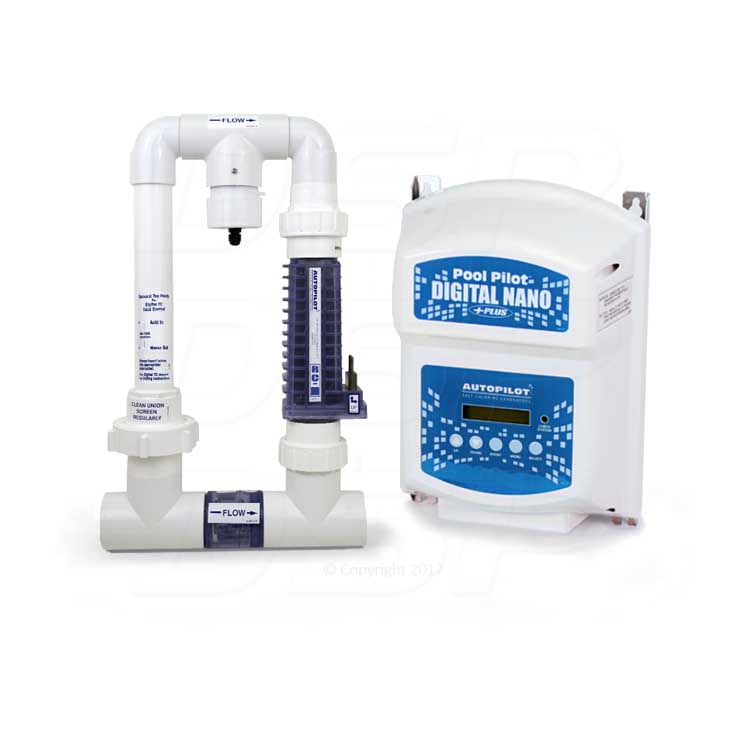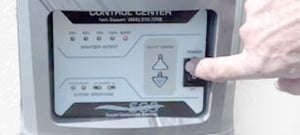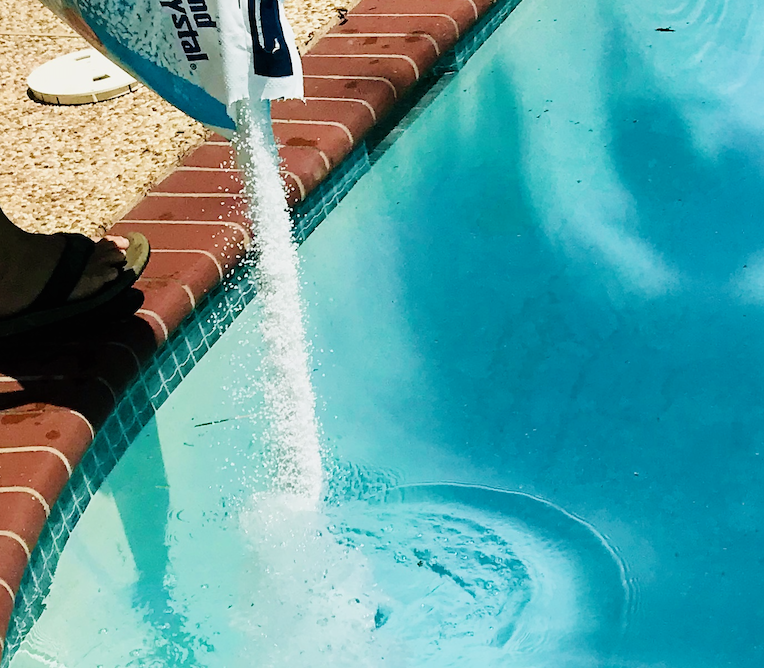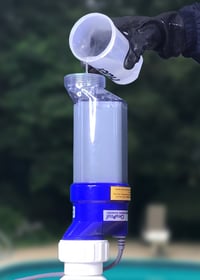How to Avoid Common Salt Pool Maintenance Issues

There are few topics with as many misconceptions as saltwater pools. Perhaps it all went wrong from the start, when the term was coined about 40 years ago. The name certainly gives you the least relevant information – the pool is not salty like the ocean, and the salt in the pool isn’t even the star of the show. So let's dive in.
A “salt pool” just means that the pool has an electronic chlorine generator installed, also called a salt chlorine generator (SCG), or an SWG (salt water generator). Put simply, an SCG utilizes a low level of salinity in pool water to continuously generate chlorine when the pool equipment runs every day. Despite the unfortunate confusion, it has still managed to become the standard in pool sanitation1. Still, there’s a lot of work that can be done to help those that care for pools understand that the differences involved when it comes to using and maintaining salt pools and their equipment.

Tips for Salt Pool Maintenance
Each of our techs work with roughly 4000-7000 customers a year on average, across all 50 states, so they have a wealth of experience when it comes to salt system maintenance. We have put together some practical, need-to-know tips for salt pools. We asked our techs to suggest the top 3 ideas that help prevent common troubles for people who maintain salt pools, and these are their choices. Hopefully these insights can be useful to you:
Recognize “set-level chlorination”
We occasionally get calls from customers who recently installed a SCG asking why their pool service tech might be still adding chlorine to their pool. They also report finding that the SCG is turned off and chlorine tablets have been added in the pool. The answer here is that chlorine should not be manually added. A chlorine generator is meant to be the primary source of pool sanitation.
That’s an easy one to start with, but let's take the idea one step further. This leads us to one bottom-line difference when it comes to salt pools. A SCG generates chlorine at the constant rate that you set, and there is a maximum rate at which SCG creates chlorine (depending on the model). This is “set-level chlorination”, as opposed to the large swings in chlorination that occur with manual addition of chlorine.
When you’re initially setting up a pool, correctly sizing the SCG is the number one factor that is going to determine how easy it is to care for the pool; you want to maximize the chlorine output of SCG that you chose.
Variable chlorine demand
When it comes to maintaining a pool, something can happen that might surprise you if you’re not ready for it: set-level chlorination can “bump up against” the variable chlorine demand of your pool (the rate at which chlorine is being used up). The idea that chlorine demand is variable is not on everyone’s radar. If you haven’t thought about it before, many factors such as weather, temperature, pool use, and especially chemical balance are always changing. Those factors (among many others) determine exactly how much sanitation the pool water needs. If you are accustomed to adding chlorine manually, this dynamic might not be apparent unless you happen to be tracking the quantities of chlorine that you use; it’s easy to get focused on the process of adding more and more chlorine and chalking things up to doing whatever it takes to keep the water blue.
Steady chlorine production
But getting constant chlorination from an SCG pushes the issue to the forefront. If chlorine demand rises and SCG operation doesn’t change, residual chlorine levels may begin dropping in the water, and the water may get cloudy. Similarly, if chlorine demand falls, you could find residual chlorine levels that are higher than what is desired. When you’re aware of that dynamic, then you can easily solve the problem. For most people, simply raising/lowering the output of the SCG on an as-needed basis is the solution most of the time. This usually just involves roughly seasonal adjustments to the SCG’s output, or temporary boosts after heavy usage or storms. Generating more chlorine is always preferable to manually adding shock or chlorine unnecessarily.
However, there are many situations where the chlorine demand can spike for reasons beyond predictable, normal causes like weather or pool usage. Whenever you find yourself needing to raise your SCG’s output, take the opportunity to check for common causes of rising chlorine demand2. If you’re having to raise your output frequently or if higher-than-average output and runtimes are needed, then checking for imbalances becomes critical. When there is a bad enough imbalance, chlorine demand can rise to the point that even an over-sized SCG can’t keep up.
Related Orenda Article: Organic Waste & Carbon Management (Pillar 2)
Identifying chemical imbalances that cause higher than normal chlorine demand allows you to address the root of your pool problems, rather than continuing in a vicious cycle of treating the symptoms of the problem. When you are used to the old ways of just dumping in more chlorine as needed until the water finally clears up, it’s not apparent to you that there might be high chlorine demand – you’re just always compensating by adding more chlorine. So this dynamic isn’t a downside of using an SCG – in fact it's making you aware of a larger pool problem that’s usually pretty easy to solve once you know about it. That’s a good thing, just like if someone pointed out to you that you have broken window pane somewhere in your house which was making you unknowingly run your home’s AC unit much harder than needed.
In our experience, most high chlorine demand issues get taken care of by eliminating phosphates, getting rid of organic waste buildup with enzymatic cleaners, and ensuring a moderate level of cyanuric acid.
Avoid “over-salting”
Here’s a common situation that can unfortunately trip you up: you replace an old cell because the SCG has been displaying error lights or giving low diagnostic readings. However, once the new cell is installed, the SCG now displays that the salinity of the pool is too high and may begin displaying a new error light!
 If you find yourself in this situation, don’t worry – you're not alone, and your SCG is not going haywire. This is “over-salting”; too much salt has been added to the swimming pool due to improper troubleshooting. We’ll help you understand why this happened and prevent it in the future. For now, if you have a high salt level, you’ll need to remove a proportionate amount of water to lower the pool’s salinity into a good range (follow all instructions in your user’s manual, it can vary by model).
If you find yourself in this situation, don’t worry – you're not alone, and your SCG is not going haywire. This is “over-salting”; too much salt has been added to the swimming pool due to improper troubleshooting. We’ll help you understand why this happened and prevent it in the future. For now, if you have a high salt level, you’ll need to remove a proportionate amount of water to lower the pool’s salinity into a good range (follow all instructions in your user’s manual, it can vary by model).
At some point, a SCG will display a warning indicator for you to check the system because it thinks that its detecting low salt levels. But this may or may not mean that you need to add more salt to the pool. But if you add salt to your pool every time the SCG gives a warning, you’re guaranteed to eventually over-salt your pool. Instead, you need to know what to check.
From the point of view of the SCG’s diagnostics, a number of other conditions can have the same appearance and cause the same warnings to be displayed. If you’re not prepared to troubleshoot it, a bad sort of feedback loop will occur. For example, when mineral scaling builds up in the SCG’s cell, it will display such warnings. Same when the SCG’s cell gets old and depleted. Raising the salinity of the water may temporarily compensate for these conditions and clear the errors. When the issue comes back, you may be tempted to add more salt again (and again, with diminishing returns) to clear the issue. Eventually, you can’t clear the error by adding more salt, and you’re left with an over-salted pool.
Warnings mean electrical resistance
A SCG is always checking the electrical power passing through its cell. A good salt level in the water makes it easier to pass power through the cell, and a bad salt level makes it harder. What is happening in the above example is that a depleted or dirty cell makes it harder to send power through the cell, but the unneeded addition of salt counteracts this for a time by making it a little easier to send power through. So how do you know whether you need to A) add salt, B) clean the cell, or C) replace the cell?
When to add salt

The most important thing to do is always test your water and independently measure its salinity before adding more salt. You don’t need to add salt unless the pool water’s salinity actually drops below range (varies by model, often levels under 3000 ppm). Salt doesn’t evaporate or break down, and the salt that a SCG uses to generate chlorine doesn’t get used up. So you only ever need to add more salt to a pool when it gets lowered due to dilution of the pool water – typically after large amounts of rain or after partially draining & refilling. Remember: refilling due to evaporation does not count. If the pool water gets diluted, the low readings and warning indicators that SCG displays could be correct, and only raising the salinity will clear these errors.
When to clean the salt cell
 If you independently check your pool’s salinity and verify that it’s in the correct range, the next troubleshooting step is cleaning your cell. A cell that has mineral scale deposits (and/or has debris inside that has made it past the filter) cannot effectively pass along electrical power and operate correctly. Clean the cell thoroughly according to your model’s user guide. Sometimes, multiple cleanings in a row are required. Be completely sure that no scale or debris remain.
If you independently check your pool’s salinity and verify that it’s in the correct range, the next troubleshooting step is cleaning your cell. A cell that has mineral scale deposits (and/or has debris inside that has made it past the filter) cannot effectively pass along electrical power and operate correctly. Clean the cell thoroughly according to your model’s user guide. Sometimes, multiple cleanings in a row are required. Be completely sure that no scale or debris remain.
If the SWG’s warning indicators were due to a dirty cell, its display readings and operation will return to normal once you restart your SCG with its cleaned cell. If not, your cell has likely reached the end of its lifespan. An SCG’s user manual may specify a few more things to check before replacing your cell, so be sure to check all relevant troubleshooting before purchasing a new one. Once a depleted cell is replaced, any previous error lights or low readings will return to normal. We’ll go into more detail about cell cleaning and how to check that a cell needs to be replaced in the next topic.
Related Orenda Article: How to Prevent Scale in Heaters and Salt Cells
An important note: different SCG models will display warning indicators differently. You may only be given a general “needs service” indicator, it may illuminate a “check salt” or “check cell” light, it may even display a message on a screen. Since every model is different, be sure to refer first to the manufacturer’s documentation, but the above instructions typically apply for any combination of warnings with regard to low salt levels or cell maintenance indicators. For example, a cell with a light amount of mineral scaling could potentially display a low salt warning, or an extremely low salt level could cause a warning to check the cell.
Know when to replace the salt cell
In some ways, a salt cell is analogous to a car tire; it’s a consumable part that slowly wears out as it works. Accordingly, there’s not really any benefit from replacing your SCG’s cell early. Getting the longest life out of your cell means getting the most return on your investment.
When a cell is depleted, the SCG’s controller typically displays an error message or warning light; as mentioned previously, such errors can sometimes be displayed due to other related issues. These are seven troubleshooting checks you should perform before replacing your cell in order to eliminate the possibility of other minor fixable issues being the cause. Unlike a car tire, you cannot visually see when a salt cell is worn out so don’t even try. Use these tried and true methods instead:
-
Verify that your pool’s salinity is in range. As mentioned previously, you should independently test this; you can use test strips, chemical reagents, or a digital tester.
-
 Clean your cell today according to your model’s user guide. Cleaning means soaking the cell in a solution of 1:4 diluted muriatic acid, not just running a hose through it or visually inspecting it3. When the cell is being cleaned, you’ll see “fizzing" similar to Alka-Seltzer. Make sure the entire internal portion of the cell is being covered by the cleaning solution. Clean it today even if you feel that it hasn’t been that long since the last time you’ve cleaned it. Depending on your pool’s LSI, it can be as little as a matter of days for scale to form if there is an imbalance. Clean your cell multiple times in a row, until you no longer see fizzing when you put the cell into a fresh batch of cleaning solution. This is because a cell with heavy buildup can potentially use up the cleaning solution’s acidity, especially in small volumes of water or if you used something weak like vinegar to clean the cell; this can make it falsely seem like the cell is clean. We’ve seen cells require 3-4 cleaning in a row to fully remove heavy buildup. Flush your cell thoroughly with a strong garden hose nozzle when done to ensure any calcium chunks or non-dissolvable debris is removed from the cell (if available, compressed air is helpful here as well). Look through the cell to visually confirm that you can see daylight between all the titanium plates in your cell.
Clean your cell today according to your model’s user guide. Cleaning means soaking the cell in a solution of 1:4 diluted muriatic acid, not just running a hose through it or visually inspecting it3. When the cell is being cleaned, you’ll see “fizzing" similar to Alka-Seltzer. Make sure the entire internal portion of the cell is being covered by the cleaning solution. Clean it today even if you feel that it hasn’t been that long since the last time you’ve cleaned it. Depending on your pool’s LSI, it can be as little as a matter of days for scale to form if there is an imbalance. Clean your cell multiple times in a row, until you no longer see fizzing when you put the cell into a fresh batch of cleaning solution. This is because a cell with heavy buildup can potentially use up the cleaning solution’s acidity, especially in small volumes of water or if you used something weak like vinegar to clean the cell; this can make it falsely seem like the cell is clean. We’ve seen cells require 3-4 cleaning in a row to fully remove heavy buildup. Flush your cell thoroughly with a strong garden hose nozzle when done to ensure any calcium chunks or non-dissolvable debris is removed from the cell (if available, compressed air is helpful here as well). Look through the cell to visually confirm that you can see daylight between all the titanium plates in your cell. -
Ensure that water is completely filling your cell when it is running. After confirming full water flow, a key check here is to turn the SCG off and then on again (while the pump keeps running). If you can restart your SCG, and it doesn’t get an error within 5-10 minutes of operation, that’s a good sign that your cell is not depleted and that you may have a flow issue. Insufficient water flow can allow pockets of air to form in the cell. This may be intermittently happening during the course of your pump’s run time, especially if you have a low-flow variable speed pump or a solar heating system.
-
Is your water temperature below 65ºF (18.3ºC)? The exact temperature at which a SCG stops running depends on the model and other factors, but getting an error during the winter can be expected. Remember that a SCG measures the temperature of the water in your PVC pipes, not the body of the pool; as outdoor temperatures change it’s possible to have colder water in your pipes, especially at night or in the early morning.
-
Carefully inspect the cable connection between your cell and your SCG’s controller. Many models will give an error when the cell cable is not properly connected. Disconnect the cable, inspect the male and female side of the plug connectors for damage, insect remains, moisture, corrosion, etc... and carefully but firmly reconnect the cable. We’ve seen instances where the cell cable appeared to be attached but was only partially connected.
-
If your model has different “cell type” settings on the SCG’s electronic controller, ensure that this setting has not inadvertently been changed. You’ll need to refer to the manufacturer’s documentation to do this, but it’s a final item to check which can cause a false error.
- Check how old your cell is. How many summers has it been since this cell was put into operation? Is it nearly as old or older than the length of its warranty period?
If all of these other troubleshooting items appear correct, and if your cell has been used for a number of years (which depends on model, sizing, and use), then it’s highly likely that you’ve gotten the maximum amount of lifespan out of your cell. If you’ve been satisfied with its performance, you can replace your cell confidently. If your current cell model didn’t have enough chlorine output for your pool’s needs, or if that model’s cells just aren’t lasting as long as they should, now would be the time for you to evaluate if you need to upgrade to a different SCG system. The electronic control units that come with most SCG’s last long enough for one or two cell changes but like most electronics, the technology improves all the time. It is usually wise to compare changing the cell vs changing the entire system if you have an older model.
Related Orenda Procedure: How to Implement the Orenda Program
Conclusion
We hope these helpful tips allow you to troubleshoot your saltwater pool system more easily. We deal with many different salt chlorine generator brands, and these tips apply to all of them. Remember that salt pools are chlorine pools, and that the chlorine is generated in the cell using electricity at a consistent rate during operating hours. When that electricity faces interference or resistance, like a dirty cell or low salinity levels, a warning light should occur. Follow the steps we listed here to troubleshoot it and you should be back up and running in no time.
If your water quality is struggling, it could be the result of variable chlorine demand meeting steady chlorine production. In that case, you can adjust your salt system's output as necessary, and optimize pool chemistry to help address the chlorine demand. Enjoy your saltwater pool!
1 According to data published in Pool & Spa News, an estimated 75% of new pools use a SCG compared with only 15% in 2002.
 About the Author: John Uhle is the Support Team Leader at Discount Salt Pool. John has over 10 years of hands-on experience with electronic chlorine generators across all brands and models. Discount Salt Pool specializes in working directly with homeowners across the country to achieve a low-chemical pool with minimal maintenance & cost, learn more here.
About the Author: John Uhle is the Support Team Leader at Discount Salt Pool. John has over 10 years of hands-on experience with electronic chlorine generators across all brands and models. Discount Salt Pool specializes in working directly with homeowners across the country to achieve a low-chemical pool with minimal maintenance & cost, learn more here.
